What is the 5×5 Workout Program?
The 5×5 workout program is perhaps the simplest and most straightforward approach to building muscle and strength. With the classic version of this program, you get to perform five barbell movements: the squat, deadlift, bench press, overhead press, and bent-over row. The exercises get divided into two unique workouts A and B.
5×5 A
Squat – 5 sets x 5 reps
Bench – 5 sets x 5 reps
Bent-Over Row – 5 sets x 5 reps
5×5 B
Squat – 5 sets x 5 reps
Overhead Press – 5 sets x 5 reps
Deadlift – 5 sets x 5 reps
These workouts are usually alternated in each workout session, so if you work out 3 times per week, your weekly schedules would look something like the following.
Week 1
Monday – Workout A
Tuesday – Off
Wednesday – Workout B
Thursday – Off
Friday – Workout A
Saturday & Sunday – Off
Week 2
Monday – Workout B
Tuesday – Off
Wednesday – Workout A
Thursday – Off
Friday – Workout B
Saturday & Sunday – Off
The principle behind this type of training is as simple as it gets: Perform five sets with your working weight of five reps of each exercise. That means, first do some warm up sets making your way up to your working weight, and then throughout the 5 sets, do 5 reps at that working weight. If you complete your sets without experiencing a breakdown in technique, add 5 lbs/2.5 kg the next time you workout. For example, if you squat 225 lbs for five sets of five on Monday, start with 230 lbs on Wednesday.
Something that will help you keep track of your reps and sets is logging your workouts in a tracker like Hevy. It will tell you how much you lifted last time, and will give you analytics to track your progress over time.
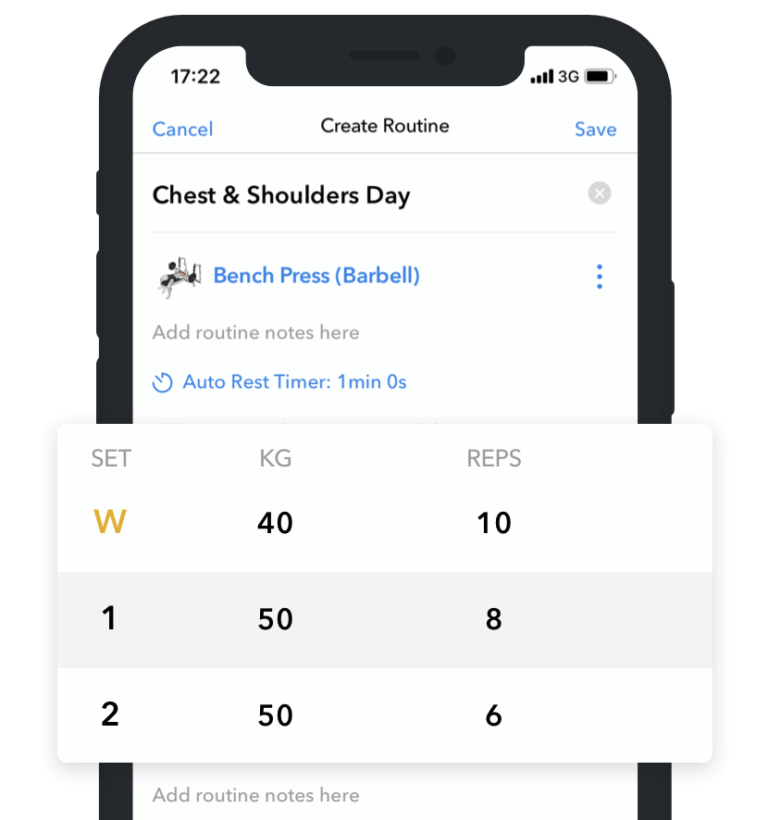
Hevy – Workout Tracker
Create your own chest workouts with Hevy, and track your progress.







Hevy – Workout Tracker
Create your own chest workouts with Hevy, and track your progress – for free.
Of course, as with any type of progression, it’s essential to remain objective with your performance. Before adding more weight to the bar, make sure you’re lifting the current weight with good form. If you’re struggling to maintain proper technique or have to reach failure on every set, it’s best to continue with the current weight for a while before attempting to lift more (1).
Also, keep in mind that this program is relatively demanding. Every workout has Squats, so assuming you workout 3 times per week, you will be squatting three times per week! It’s best to start with a lighter weight – somewhere around 50 percent of your 1 RM and slowly work it up over the weeks.
The 5×5 Workout Plan
Now that we have some idea what the 5×5 program entails, let’s design a plan. This program will have two unique workouts (A and B), you will train three days per week, and you will alternate between the two workouts. Meaning, you will complete one cycle every two weeks.
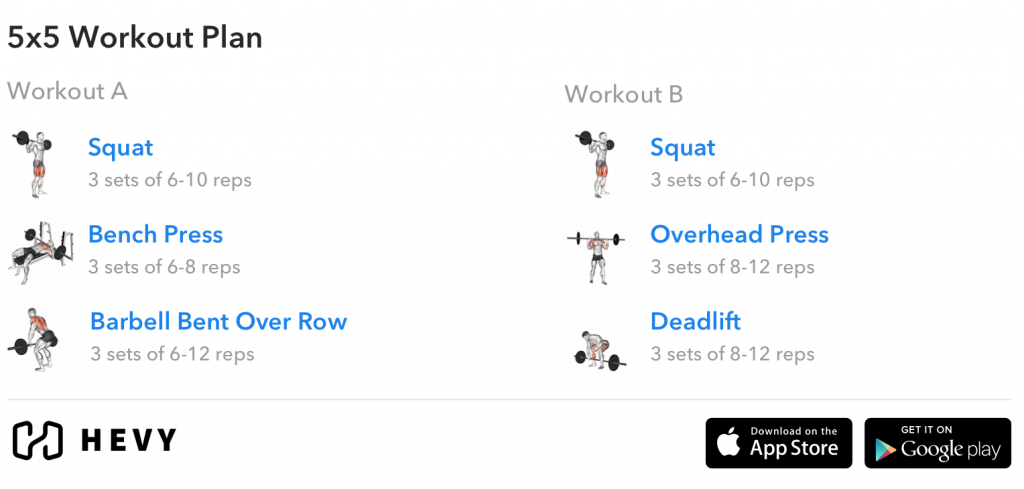

Here is how it would look:
Week 1
Monday – Workout A
Tuesday – Off
Wednesday – Workout B
Thursday – Off
Friday – Workout A
Saturday & Sunday – Off
Week 2
Monday – Workout B
Tuesday – Off
Wednesday – Workout A
Thursday – Off
Friday – Workout B
Saturday & Sunday – Off
Here are the two workouts:
Workout A
Back Squat – 5 sets x 5 reps
Barbell Bench Press – 5 sets x 5 reps
Bent Over Row – 5 sets x 5 reps
Workout B
Back Squat – 5 sets x 5 reps
Barbell Overhead Press – 5 sets x 5 reps
Deadlift – 5 sets x 5 reps
Picking Your Working Weights
As you’re just getting started with the 5×5 workout program, you should definitely ease into it. Depending on how you’ve been training so far, easing into this can vary in length and magnitude. In general, we recommend starting more conservatively and building from there.
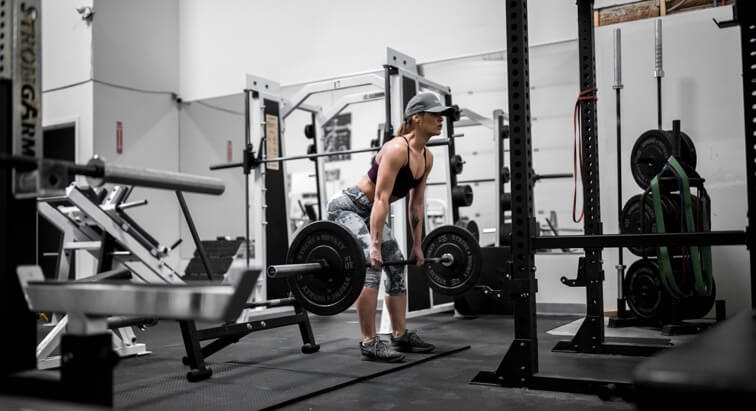

For example, if you have a good idea of your 1RM on the core lifts, start with around 50% of your 1RM. For instance, if your best bench press is 230 lbs, start your working sets with approximately 115 lbs. This achieves two things:
First, it helps you get accustomed to the program and frequency. Second, it allows you to gain momentum and get a good feel for progression. Instead of plateauing after a couple of weeks because your starting weights were too heavy, you get to increase the weight over several weeks steadily. This is great for motivation and morale.
Check out our PR workouts article to learn more about testing your 1RM, when you should do it, and how to select the appropriate weight.
Warming Up Properly
Besides the mandatory warm-up routine you would do before every workout, we recommend doing some basic warm-up sets for each exercise. In general, it’s best to start with an empty barbell and make modest increases in weight until you reach your working weight. Warming up properly will help boost longevity and allow you to train more effectively (5) long term.
Rest Between Sets
The primary objective of resting between sets is to allow your muscles to rest temporarily to gather enough strength to do your repetitions as designed in the workout. This will depend on the individual, but general recommendations suggest resting anywhere from two to five minutes between sets with heavier weights.
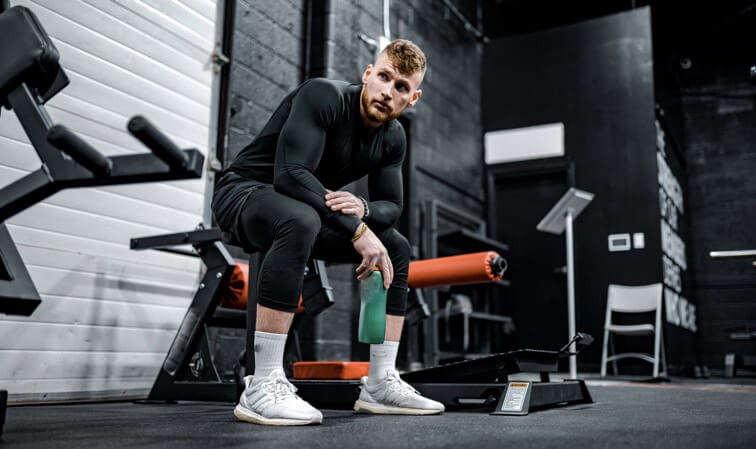

When in doubt, rest a bit more rather than less. This is linked to superior muscle gain over time and allows you to perform better on each set (6).
Progression With 5×5 Workout
The 5×5 program is simple to understand and follow. Of course, this doesn’t make it easy. As we discussed above, this program employs a linear progression model. Meaning, you use the same structure in each workout and only increase the weight when you get, that’s right, five reps across five sets.
For instance, if you start bench pressing with 135 pounds and you get 5, 5, 5, 5, and 4, you stick to that weight until you cover the progression requirements. In contrast, if you get your five reps on all sets and even do more on some sets, then you have a green light to move up.
In general, adding 2.5kg (5lbs) to the bar is a good idea. For example, if you get five reps across five sets on the bench press with 135 pounds, train with 140 pounds next time.
Most folks recommend adding 5kg (10lbs) on the deadlift, but you should always use your best judgment when adding more weight. For example, if you get 5×5 with 300 pounds, you can try 310 pounds the next time. If that feels too heavy, there is no shame in adding only 5 pounds and going for 5×5 with 305.
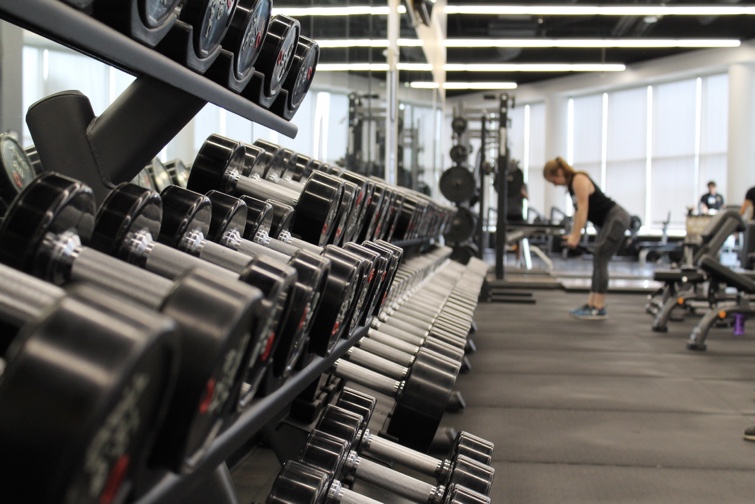

As far as the overhead press and bent over row, you can make even smaller increases of around 1kg (2lbs). The reason is, progress happens more slowly on these exercises, and adding too much weight can quickly ruin your technique. It’s better to take it slow and progress linearly for longer.
Okay, but how good is this way of progress? Well, research certainly supports it. In one recent study, researchers found that linear periodization allowed older adults with sarcopenia (muscle atrophy) to build more strength and muscle (13). They also had to do less work to achieve this effect.
A systematic review and meta-analysis compared linear periodization to DUP and found them similar for muscle hypertrophy (14).
With consistency and hard work, linear programming can be a simple and fantastic way for folks to get stronger and build muscle.
The Three Most Significant Benefits of the 5×5 Workout Program
1. It Offers An Optimal Training Frequency
According to research, training our muscles twice per week is superior for hypertrophy than once (3). Despite its moderate training volume, the 5×5 program offers an optimal frequency, which is great for those who also want to build muscle besides strength.







Hevy – Workout Tracker
Create your own chest workouts with Hevy, and track your progress.







Hevy – Workout Tracker
Create your own chest workouts with Hevy, and track your progress – for free.
Although the classic program has you do just five exercises, each of them trains a range of muscle groups. Together, they provide an adequate stimulus to the major muscle groups in your body and offer a simple approach to building muscle. Plus, because each movement is done with a barbell, the overloading potential is fantastic, and you get to impose significant mechanical tension, which is a crucial factor for muscle hypertrophy (4).
Other workout programs that also offer great training frequency are the Push Pull Legs (PPL) plan, or an Upper Lower Plan.
2. It Helps You Develop Neuromuscular Efficiency
Neuromuscular efficiency refers to your ability to recruit more muscle fibers to produce force. Peak efficiency is specific to the tasks, but it also benefits other activities. For example, the more you back squat, the better you will recruit your muscles for that specific task. This isn’t to say that back squatting can’t benefit your performance on other movements, such as the front squat.
The 5×5 workout program is great for neuromuscular efficiency because it allows you to work through specific movement patterns multiple times per week (2). For example, you get to squat three times per week, which allows you to improve your ability to recruit motor units for that specific movement pattern.
As a result, you can see steady improvements in squat performance without necessarily gaining muscle mass.
3. It’s Simple (And Has a Clear Objective)
Let’s face it, training programs come in all shapes and sizes, and some are incredibly complicated. The beauty of the 5×5 workout program is that you have clear training objectives and following the workouts is simple. Progressing is also straightforward, and you rarely have to wonder about any aspect of your training.
The Main 5×5 Exercises
Squat
The squat is one of the most natural and practical exercises you can do to strengthen and develop your lower body musculature (7). Specifically, the squat emphasizes your quadriceps – the primary knee extensors. Besides that, squats also train your posterior chain (hamstrings, glutes, back), abdominal muscles, shoulders, and arms.
The primary muscle group in the squat is the quadriceps, but other muscle groups work to keep the barbell’s position, help you maintain a rigid structure, and stay balanced throughout each repetition.
In the context of the 5×5 program, the squat is vital because it works great in combination with the other exercises (which we’ll look at next) and allows you to achieve complete muscular development.
Speaking of that, we recommend that you go with front squats or high-bar back squats for the 5×5 workout program (8). The reason is, both of these exercises work well with a high training frequency, and your risks of developing aches or overtraining yourself are much smaller.
In contrast, low-back back squats can lead to elbow and shoulder pain for some individuals when performed too frequently.
As far as technique goes, make sure that each repetition is of high quality. Squat as low as you comfortably can and make sure that your heels never lift off the floor. As you’re ready to squat up, push through your heels.
Bench Press
The bench press – a classic exercise and one that every gym bro & gal on the planet does with religious dedication. It’s an exercise that lives up to its reputation and delivers impressive benefits when done correctly and intelligently.
What’s the first question people ask when you tell them you lift weights? That’s right: “How much do ya bench, bro?”
But what makes this exercise so valuable? Most notably, the bench press is one of the best chest-building activities out there (9). It targets the chest muscles well, the overloading potential is fantastic, and learning how to do it correctly doesn’t take a tremendous amount of time or effort. Plus, its mobility requirements are low, and most average people can get good at it. The chest is one of the most important muscle groups for women and also one of the most neglected, we’ve written about this in another article, chest exercises for women.
In the context of the 5×5 program, the bench press is even more valuable. It is your primary (and only) horizontal pressing exercise that develops your chest, shoulders, and triceps. It helps complete the 5×5 workout program in a way that optimizes your physical development and strength.
As a relatively simple exercise, many people jump to the bench press and load the barbell up. It’s important to be mindful of a few crucial things:
- Learn how to use leg drive correctly. This will make a massive difference in your stability and power output.
- Keep your elbows relatively tucked in. Avoid flaring them out, as that puts your shoulders in a compromised position.
- Learn how to keep your shoulders back and down. Like the previous point, this will also help keep your shoulders in a safe, healthy, and strong position for pressing.
Barbell Bent Over Row
The barbell row is another fantastic exercise and one that strengthens and develops your entire back, shoulders, biceps, and grip strength. In general, you can pick between two variations:
- The classic bent-over row where you bend forward and keep the barbell off the floor at all times.
- The Pendlay row where you bend forward a bit more and rest the barbell on the floor between repetitions.
Both variations work great, and it’s worth experimenting to see which one works better for you. What matters most is that you feel the exercise well, it doesn’t put any strain on your lower back, and it activates your back muscles properly. So long as you cover these criteria, you can pick whichever version you prefer.
In the context of the 5×5 program, the barbell row is one of two back-building exercises. It works great for building your pulling muscles – lats, rhomboids, trapezius, rear deltoids, and biceps. Thanks to that, it also benefits your deadlift performance and allows you to make more predictable progress.
To do this exercise effectively, what matters most is that you perform each repetition with a good range of motion and avoid momentum. Sure, adding speed to the mix can help you train with heavier weights. But that often comes at the expense of optimal muscle activation, which defeats the exercise’s whole purpose.
In general, you won’t gain as much strength on the barbell row when compared to other exercises, so it’s important to be mindful of your technique at all times and realize that small improvements add up.
Deadlift
Volumes have been written about this fantastic exercise. Similar to the squat, deadlifts are a whole-body
exercise that helps strengthen and develop a range of muscle groups in the body (11). What’s even more impressive about deadlifts, is that they improve intramuscular coordination and have many sport-specific applications.
Your legs, glutes, hips, and back must work together to help you lift the barbell off the floor and to the top position. Also, your abdominal muscles contribute to spinal stability, your arms help keep the barbell on the right track, and your hands work hard to grasp the weight.
Thanks to this, deadlifts allow us to train with heavier weights and make more predictable strength progress. It’s not uncommon for serious trainees to develop a deadlift in the 300, 400, and even 500-pound range over time.
In the context of the 5×5 program, the deadlift serves an essential purpose to help train your posterior chain and improve leg strength. When done consistently, it helps develop a wide range of muscle groups and improves your performance on the other exercises, primarily the squat and barbell row.
What’s even better about the deadlift is that you can pick from different variations, depending on your preferences and anatomy. For example, if you find conventional deadlifts to be awkward, you can instead go for sumo (12).
What matters most is that you always practice good technique. The deadlift can improve us, but we need to respect it and do each repetition with good form. Most notably, aim to keep your back in a neutral position. If your back tends to round, the issue could relate to poor mobility, using too much weight, or not bracing correctly.
Overhead Press
Despite what some say, the overhead press is a full-body compound exercise that trains your shoulders and a range of other muscles (13). Your shoulders, upper chest, and triceps do most of the work, while your core musculature helps keep you stable.
Because of its biomechanics, the overhead press develops your pushing strength, improves your balance, and teaches you how to brace more effectively.
Unlike some exercises where cheating helps folks lift heavier weight, the overhead press is a humbling movement. To press heavy weights above your head, you need to be strong, and there is no way around it. Sure, you can use some leg drive and momentum to help yourself. But if you don’t have a solid foundation, you won’t find yourself making good progress in the long run.
In the context of compound training, the overhead press is among the most challenging movements because you can’t press that much weight, and progress happens more slowly. This can feel a bit disheartening at times, but you need to accept it as fact and give it everything you’ve got.
The overhead press is an excellent addition to the 5×5 workout program precisely because it allows you to develop your pushing strength in a different plane – vertically. Doing so benefits your bench press and helps further develop your chest, shoulders, and triceps.
What matters most is that you perform each repetition with good form and a full range of motion. Lift the barbell and lower it in a controlled fashion, avoid using momentum, and avoid dropping the bar from the top position.
On a similar note, be more conservative with your loading and progression. Add more weight to the barbell only when you’re confident that your technique is excellent and you’re ready for a heavier load.
Rest Days During the 5×5 Workout Plan
In general, the 5×5 program is quite flexible because you only have to train three days per week. For instance, you can follow the classic outline of Monday, Wednesday, and Friday. Alternatively, you can train on Tuesdays, Thursdays, and Saturdays. Both options will work equally well, and it mostly depends on your preferences and availability.


You should always leave at least a day of recovery in-between sessions to prevent a drop in performance. If you do your workouts in a row, you’ll run into issues. For example, your legs will be fatigued from squatting, and you won’t be able to perform well the next day. Similarly, your shoulders, chest, and triceps will also be tired.
Training is vital for causing a stimulus. But your recovery is what then allows that stimulus to turn into an adaptation (15). If you don’t give yourself enough time to recover between workouts, the program won’t be useful because you won’t perform at your best.
Adapting the 5×5 Workout To Your Goals
Another great thing about the 5×5 program is that you can adapt it to your goals. In other words, even if strength isn’t your single and most important goal, you can take the principles of 5×5 and create yourself a more versatile program.
For instance, you might want to include more assistance work for the individual muscle groups in your body. In doing so, you’ll be able to do more volume and hopefully cause greater hypertrophy (16).
The bench, squat, deadlift, bent over row, and the overhead press will deliver significant results. But adding assistance work can help you achieve even better results, provided you recover well, and your nutrition is on point.
Here are some exercise ideas:
- Biceps – chin-ups and various curls
- Triceps – dips and extensions
- Shoulders – lateral raises and face pulls
- Abs – hanging knee raises and planks
- Chest – flyes and push-ups
- Back – lat pulldowns and dumbbell rows
- Quads – leg press, leg extension, and lunges
- Hamstrings and glutes – glute-ham raises, leg curls, and donkey kicks
- Calves – calf raise variations
Here is how you might add some accessory and isolation work to the standard 5×5 workouts:
5×5 Workout A – Accessory
High-Bar Back Squat – 5 sets x 5 reps
Flat Barbell Bench Press – 5 sets x 5 reps
Bent-Over Row – 5 sets x 5 reps
Dumbbell bicep curls – 2 to 3 sets of 12 to 15 reps
Cable rope tricep extensions – 2 to 3 sets of 12 to 15 reps
Cable rope face pulls – 2 to 3 sets of 12 to 25 reps
5×5 Workout B – Accessory
High-Bar Back Squat – 5 sets x 5 reps
Standing Barbell Overhead Press – 5 sets x 5 reps
Conventional Deadlift – 5 sets x 5 reps
Classic push-ups – 2 to 3 sets of 10 to 20 reps
Unilateral dumbbell rows – 2 to 3 sets of 10 to 15 reps
Leg extensions – 2 to 3 sets of 12 to 20 reps
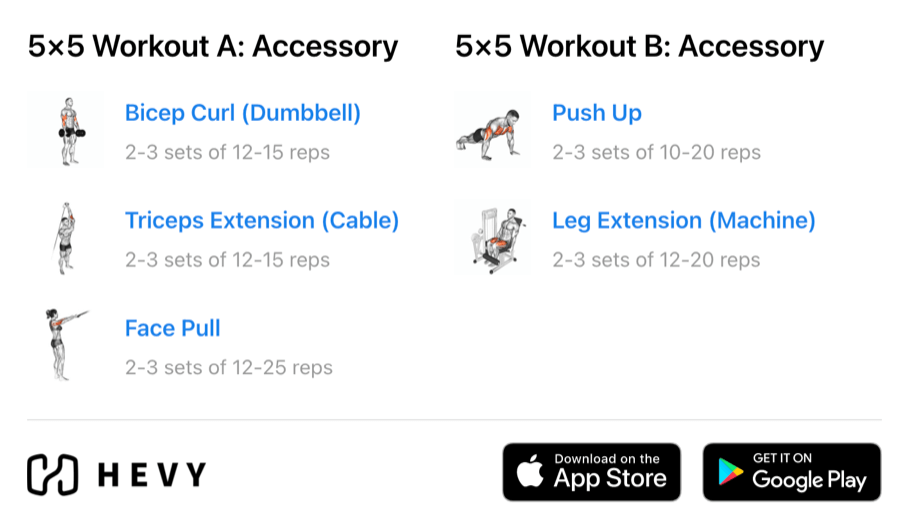

Alternatively, you might want to add some cardio to your strength training – that’s also a great idea. It’s best to do cardio on your recovery days to minimize the interference effect (17). It’s also better to go for less impactful forms of cardio like cycling. For example:
Monday – Workout A
Tuesday – 40 minutes of low-intensity cardio
Wednesday – Workout B
Thursday – 40 minutes of low-intensity cardio
Friday – Workout A
Saturday & Sunday – off
With all of that said, we do recommend easing into the 5×5 program, doing a proper introduction (where you start with lighter weights initially), and seeing how things go. Once you get used to the tempo of the 5×5 program, you can look for ways to mold it to your specific style and goals.
The more exercises you include, the harder it will get to recover on time. So, be mindful when making any adjustments to the original program and monitor how they impact you.
Who is the 5×5 Workout Program For?
You might be wondering, “Well, this 5×5 program seems good, but is it good for me?” In general, the 5×5 workout program can work great for almost everyone. Unless you’re recovering from injuries (in which case, always consult with your doctor) or are quite advanced, the 5×5 program will produce good results.
The program works great for beginners because it leads to rapid strength and muscle gains initially and helps them maximize their newbie phase. At the same time, the program isn’t that demanding to prevent beginners from gaining momentum. All you have to do is learn five exercises, have three weekly workouts, and follow a simple progression scheme.
With enough consistency and proper nutrition, this program can deliver steady results for a long time.
Intermediate lifters can also achieve great results on 5×5 programming thanks to the high training frequency. According to research, training our muscles twice per week seems optimal for hypertrophy, but training three times a week can also work great (3). As far as strength is concerned, performing the different lifts more often will lead to quicker results (2).
Like many things, your lifting performance also depends on skill to some degree. The more you work on an exercise, the better and more technically-proficient you become.
Popular 5×5 Workout Plans
Stronglifts 5×5
Let’s summarize the Stronglifts 5×5 program:
- You have five exercises – the bench press, squat, barbell row, overhead press, and deadlift.
- You have two workouts to alternate between – Workout A and Workout B.
- You have to train three times per week.
- Make sure to always have at least a day of recovery in-between your training sessions – for example, Monday, Wednesday, and Friday.
- The program follows a linear progression model – increase the weight once you do five sets of five reps with the current load.
- Add more weight only when you’re confident that your technique is good and you control the weight well.
- Add up to ten pounds on the deadlift, five pounds on the squat and bench, and as little as 2.5 pounds on the overhead press and row. The goal is improvement, not technique sabotage.
- It’s good to start with lighter weights at first – around 50 percent of your 1 RM. This will help you get used to the program and make linear improvements for longer.
- Rest anywhere from two to five minutes between sets. The goal is to recover well so that you can do your prescribed repetitions across all sets. Rushing the workout will only sabotage your performance and slow down progression.
The Stronglifts 5×5 program, as outlined, is usually better for beginners. Once a lifter becomes more advanced, they can run into some issues, which the Madcow 5×5 program addresses. Let’s see.
Madcow 5×5
One of the biggest differences between Stronglifts 5×5 and Madcow 5×5 is the program that with Stronglifts 5×5, you get to add weight each workout, however on Madcow 5×5, the goal is to add weight each week.
Besides this significant difference, both programs share similar details. The principle of progression, exercise selection, and workout structure are similar. Training volume differs, you’re using varying loads, and you now have some lighter work in the middle of your training week.
Specifically, you no longer do five sets of five reps across exercises but instead ramp up the intensity and end up doing a single heavy set of five reps. Your second squat workout of the week is also lighter. You’ll be training with a bit less weight to give yourself enough time to recover from the first heavy workout of the week. And, of course, you’ll only aim to add weight to the bar every week instead of every workout.
But why is this the case? The issue is, we can’t make linear progress forever. In other words, one tactic might have helped you boost your squat from 60 to 250 pounds. But you’ll need a significantly different approach to go from 250 to 350 pounds. And yet another method to go from 350 to 450.
Plus, as the weight gets heavier, recovery demands increase. Sure, you might be able to squat 135 pounds for 5×5 on Monday, go back on Wednesday, and do 5×5 with 140 pounds. But you won’t be able to do the same with 250+ pounds. Recovery is still the crucial element for positive adaptations, and Madcow simply emphasizes it.
What Are The Pros And Cons of the 5×5 Workout?
Pros
- It’s straightforward to set up and get started. All you need to do is set up three simple workouts and pick starting weights.
- You don’t have to dedicate yourself to a high training frequency and be at the gym five times per week.
- You have a clear and straightforward progression scheme to follow – once you do five sets of five reps, move up the weight.
- Your objectives are clear, and you don’t have to deal with complicated programming or load selection.
- Improvements happen predictably for a long time. It’s not uncommon to squat, bench and deadlift well into the 200 pounds on this program.
- Thanks to the high frequency, you get to develop sound technical proficiency for these core exercises.
- The program is also suitable for hypertrophy because it offers plenty of training volume and a high training frequency for each muscle group.
- You can add accessory work or cardio to make it fun and more varied.
Cons
- It takes some time to master the core barbell lifts – you need careful planning and execution to get better over time.
- There is a risk of injury if you’re not careful. These barbell lifts are complex and small errors in technique can compound. Every repetition needs to be good.
- While seemingly simple, the 5×5 program is not easy. You’re only doing barbell exercises, which are quite taxing, and you need to push yourself from workout to workout.
- Workouts are long. Between warming up, doing warm-up sets, preparing the barbell, and resting enough between working sets, it’s not uncommon to train for well over an hour. This can be challenging if you don’t have as much time for working out.
- It can be tedious to go through 5×5 workouts because you have to spend most of the time resting between sets.
Comparison With Other Training Plans
5×5 vs. 3-Day Split
The 3-day split has always been popular among trainees because it works. Like the 5×5 program, you only have to train three days per week, but each workout is challenging and helps you achieve fantastic results. It’s a good starting point for beginners because the high frequency helps improve lifting skills and optimizes muscle gain.
The question is, which of the two is better? Both are in their unique ways. For example, the 5×5 workout program is excellent because it shows you exactly what you need to do. But it’s also more rigid, and there is little flexibility.
5×5 vs. Upper Lower
The upper lower split is also popular among trainees because it offers an optimal training frequency and allows for decent strength gains. The most common way to do the upper lower split would be to have four weekly workouts – two upper and two lower. You can also train three times per week and alternate between a lower and upper body workout over the weeks.
Compared to the 5×5 program, an upper lower split is more of a hybrid approach. The different thing about an Upper Lower Split, or a Push Pull Legs (PPL) program is the division of muscle groups during each workout day.
5×5 vs. Bro Split
The bro split, while not as popular as it once was, still has merit. It’s a highly flexible approach to training that helps trainees make good strength and muscle improvements. The goal is to dedicate specific days for training given muscle groups – for example, chest on Monday, back on Wednesday, and legs on Friday.
The issue is, bro splits typically work better with a higher frequency where you don’t have to train more than one or two muscle groups in a workout. Three-day versions can work, but your workouts will have to be much longer.
In terms of effectiveness, it can be beneficial for muscle gain. But the 5×5 workout program would be the better choice, given the many benefits and fantastic strength improvements you can make.
Conclusion
The 5×5 workout program is a tried-and-true method for getting stronger and building some muscle in the process. Countless individuals have used this simple training program and have made fantastic strength progress in a matter of months.
The main points about the program are:
- Start light and ramp up the intensity slowly
- Train three days per week with at least a day in-between for recovery
- Focus on great technique on every repetition
- Once you get 5×5 with a particular load, increase the weight and start over
- Rest enough between sets to maintain your performance on each set
- Once 5×5 stops working as intended, move to Madcow 5×5
What’s even more impressive about 5×5 workout is the simplicity. This program is evidence that simple programming can work for a long time. If you’re looking to stay consistent over time, tracking your workouts with Hevy will help!







Hevy – Workout Tracker
Create your own chest workouts with Hevy, and track your progress.







Hevy – Workout Tracker
Create your own chest workouts with Hevy, and track your progress – for free.
Too many people look for the most complicated approach, where something clear and simple would work much better. All you have to do is select light enough loads, remain consistent, do your five sets of five, and make small steps up.
Frequently Asked Questions
The 5×5 training plan is a strength program designed to help you build whole-body strength, athleticism, and muscle mass. It employs a linear model of progression. Once you achieve 5×5 with a given weight, add a bit extra for your next workout.
Cardio is not mandatory for 5×5 success, and doing too much can interfere with your strength adaptations (17). Still, if you want to do some cardio for good health and improved recovery, it would be best to do it on your rest days. If that’s not possible, do cardio after your main lifting work.
There is quite a bit of overlap on a 5×5 program, which makes it efficient—for instance, the squat and deadlift both train a large percentage of the body. The overhead and bench press both train the chest, shoulders, and triceps. The deadlift and row both train your arms, shoulders and back.
We could make a case that all five movements train most muscle groups in the body, at least to some degree.
The 5×5 plan is inherently superior to most training programs out there because of its simplicity. It’s simple to set up and follow; you don’t need a coach to tell when you should add more weight, and you don’t have to do countless exercises.
The goal is to master the fundamentals, apply them consistently, and push yourself hard.
The simple answer? Your workouts should be as long as needed for you to complete all of your sets systematically. In other words, you need to rest enough between sets to maintain your performance as the workout progresses. The goal here is adequate recovery. Trying to rush through your training won’t be good for your long-term development.
Yes, the 5×5 program is fantastic for beginners because it helps them establish a strong foundation and teaches them how to perform five of the most important lifts in the gym.
With that said, complete beginners should work with a coach, at least in the beginning, and it’s always a benefit to track your workouts. A good coach will teach them proper technique, monitor their workout performance, motivate them, and give them helpful tips and insights.


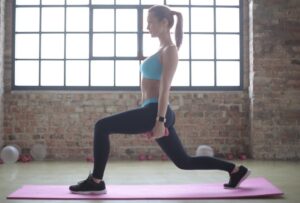

5 thoughts on “5×5 Workout Program – The Ultimate Guide (2024)”
Loved the article! Thank you so much for sharing it.
Any thoughts on swapping the deadlift? I know it’s a core lift but it keeps bothering my back and I was wondering if I can swap it for something else?
Hey Phil! Yes you can absolutely swap out exercises if they are not suitable to you. Rack pulls tend to be a great alternative to deadlifts, since the range of motion is more controlled. You could also try exercises like the Barbell Hip Thrust for your glutes, Back Hyperextensions for your lower back, or some Nordic Hamstring Curls for your hamstrings. Good luck with your training!
Amazing information, definitely Adapting it to my workout sched. Wondering what my diet should look like with this split.
I train a football team(High School) we can only train them on Monday,Tuesday,Wednesday, Thursday. Any suggestions on a split
Hey Joseph! You could try an Upper/Lower split, which we have also written about. You would simply alternate Upper/Lower body in alternate days.